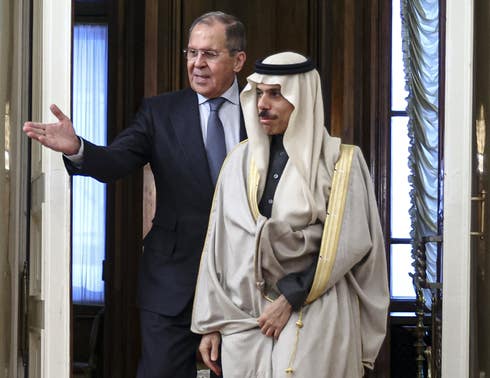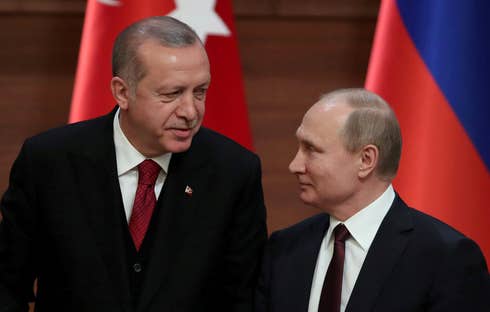Putin sees the region as a zero-sum game against the United States and can respond with sanctions of his own, having created a Mideast presence while America slept
By Zvi Bar’el, HAARETZ Feb 25/22
In 2005, five years after he was elected Russian president, Vladimir Putin said in a speech that “the demise of the Soviet Union was the greatest geopolitical catastrophe of the century. … Tens of millions of our citizens and fellow countrymen found themselves outside the Russian Federation.”
As he put it, “our place in the modern world, I want to stress this particularly, will be determined only by the degree of our strength and success.”
His invasion of Ukraine as a first step to occupying the whole country, eight years after annexing Crimea, looks like the implementation of his ambition to build a new global order.
In this new world, Russia won’t only restore its status as a power equal to the United States, it will overshadow it. It will portray Washington as feeble, set the rules of the game for Europe, the Middle East and Asia, and shatter the Western-American hegemony that since the Soviet Union’s collapse has dictated the blocs, alliances, loyalties and financial investments around the world.
The Middle East is a key player in the new Russian strategy. In 2015, a year after annexing Crimea, Putin used the war in Syria to send a message to the Arab countries and the United States. The Russian air force, army and mercenary militias regained for the Assad regime control over around 80 percent of Syria’s territory.
This wasn’t only aid to a friend or a plan to take over Syria’s oil. Russia created a new balance of power that spread to other Arab and Muslim states. It cracked America’s exclusivity in managing regional crises. As part of his penetration into the Middle East, Putin offered Iran an ideological partnership based on labeling the United States a mutual enemy.
But then, as is his wont, he caressed with one hand and slapped with the other. When this partnership faced a test in Syria, Putin sidelined Iran, denied it economic gains, let Israel strike Iranian targets and threatened Tehran’s ability to influence developments in Lebanon.
- Turkey might pay for its support for Ukraine – in Syria
- Erdogan is worried, Iran sees an opportunity: The Middle East nervously watches Ukraine
- Russia-Ukraine crisis: Will Erdogan turn his back on Putin?
At the same time, Moscow formed a semblance of a strategic partnership with Iran by signing long-term trade and arms deals. The contracts have yet to be implemented, but Iran can use the signatures as proof that it’s not alone in the world.
Another example is Russia’s involvement in the civil war in Libya, where it sponsored separatist Gen. Khalifa Hifter, becoming an ally of the United Arab Emirates, Saudi Arabia and Egypt while also meeting with the recognized government and making it promises.
The strategic principle guiding Putin is the Cold War precept of a zero-sum game: Any American achievement is a loss to Russia and vice versa. In what is known as “conflictual cooperation,” Russia maneuvers between those who share its interests and those who threaten them, as long as the result is acknowledging the necessity of Russia’s involvement.
Oil skirmish with Riyadh
This principle led Russia to forge a stronger relationship with the UAE and Saudi Arabia and even once again suggest a security forum consisting of the Gulf states and Iran under a Russian umbrella. Russian Foreign Minister Sergey Lavrov, who made this proposal on his visit to the Gulf states in March and April last year, was politely refused.
The Gulf states, especially Saudi Arabia, haven’t forgotten Russia’s oil war against them in 2020. Russia, then a member of OPEC+, rejected the organization’s demand to cut production due to the lower demand during the pandemic and withdrew from the group. The Saudis responded by reducing prices by $6 to $8 per barrel, sending world oil prices below a meager $20 a barrel.
The damage to Russia and the other oil producers, including American ones, was huge, and even Saudi Arabia was forced to cancel giant billion-dollar projects. Then-U.S. President Donald Trump put massive pressure on Riyadh, threatening to deny it military aid unless it stopped lowering prices and reached an agreement with Russia. Such a deal was reached in April 2020.

Russian Foreign Minister Sergey Lavrov meeting with his Saudi counterpart, Faisal bin Farhan Al-Saud, in Moscow a year ago. Credit: Russian Foreign Ministry Press Service / AP
The oil war didn’t stop Russia from negotiating with Saudi Arabia over investments and economic cooperation a year later, but Riyadh hasn’t made significant investments in Russia yet. Meanwhile, the frequent talks that the Saudis, the UAE and Iraq held with Moscow left the impression, especially in the United States, that the Gulf states were trying to find an alternative to the exclusive alliance with the United States.
This impression is still far from reflecting reality. The Gulf states are tightly bound to the Western market, especially the U.S. one. But they can use the Russian connection to threaten the United States not to stray from the policy that has shaped the Arab-American alliance for decades.
Egypt is also maneuvering between Russia and the United States. In 2017 it signed an agreement for a Russian nuclear reactor to be built in the Alexandria region; the following year came a deal to buy Russian Sukhoi Su-35 fighter jets. Cairo said it wanted to diversify its arms sources after Washington blocked the sale of planes and missiles in 2013 due to Egypt’s severe human rights violations.
The United States warned Egypt that the Sukhoi deal could lead to heavy sanctions, but the threat wasn’t carried out. Thus Russia not only supplied advanced weapons, it warned Washington not to treat Egypt like a puppet.
Plus the construction of the nuclear reactor, which will be financed by Russian loans, isn’t only an economic endeavor. A reactor and warplanes mean Russian scientists, technicians and instructors will be in Egypt for decades, a diplomatic foothold as well as a military one.
Mixing it up with Erdogan
But the best example of the “conflictual cooperation” policy is Russia’s relationship with Turkey. The latest chapter in this campaign began in 2015, when Turkey shot down a Russian fighter jet, claiming it had entered its airspace near Syria. Russia’s response was swift and painful: an almost complete economic boycott.
Turkish companies operating in Russia were forced to leave, and Russian tourists, the mainstay of the Turkish tourism industry, weren’t allowed to fly to Turkey. About eight months later President Recep Tayyip Erdogan apologized to Putin and the two signed a strategic cooperation agreement. After that, Erdogan showed contempt for NATO and Trump and bought S-400 missiles, creating a wide rift with Washington and leading Trump to impose sanctions on Turkey.

Turkish President Recep Tayyip Erdogan meeting with Putin in Ankara in 2018. Credit: Umit Bektas / Reuters
Turkey and Russia then engaged in conflictual cooperation in Syria amid Turkey’s desire to take over the Syrian part of the border area, while Russia demanded that Turkey remove the rebel militias from the Idlib province there. Here too the United States was absent and left Syria as an Erdogan-Putin arena.
What looked like Russian-Turkish cooperation in Syria turned into a political clash in Libya, when Russia and Turkey helped Azerbaijan while Russia backed Armenia in the 2020 war. All told, this series of confrontations has shown that the Syrian front is only one of several on Russia’s agenda as targets of direct or indirect occupation.
The invasion of Ukraine put Turkey in a serious dilemma very similar to the one facing Israel. Turkey sold Ukraine advanced drones and received a harsh warning from Russia. But Erdogan seems to have made a strategic decision to stand by Ukraine. He has announced he will continue to sell the “Ukrainian people” weapons, and on Thursday he strongly denounced the Russian invasion, declaring that Turkey doesn’t recognize Putin’s moves against Ukraine’s sovereignty.
This is undoubtedly a daring move by a leader whose country depends on Russia for its gas, oil and tourism. The price of Turkey’s gamble is not yet clear.
The U.S. and European sanctions on Russia will exact a heavy toll and shake the world’s economies. But unlike Iran or Syria, Russia can respond with sanctions of its own and divide the region into countries that supported or at least didn’t condemn the invasion, and those that joined the “American enemy.”
Russia and Ukraine are the Middle East’s largest wheat suppliers. The price of wheat has already spiked, and poor countries like Egypt, Lebanon and Jordan will have to raise bread prices, which could stoke protests and civil unrest.
In contrast, it’s doubtful whether Russia wants to punish Muslim countries even if they denounce it. Around 25 million Muslims live in Russia.
The invasion of Ukraine is a threat to the Muslim states that emerged after the collapse of the Soviet Union – Uzbekistan, Azerbaijan, Turkmenistan, Kazakhstan and Kyrgyzstan. If Putin wants to set up a new Soviet Union, these countries too could be on his annexation list, if not militarily then definitely politically and economically.
These states haven’t raised the Islamic flag in solidarity with Middle East Arabs and the large Muslim countries of Indonesia and Malaysia. But they might if the Russian threat becomes concrete.



Leave a Reply
You must be logged in to post a comment.